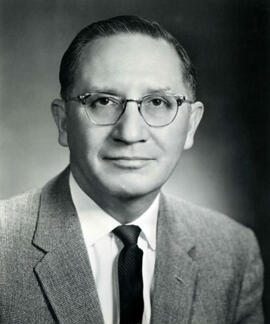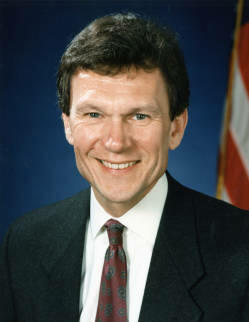The Ben Reifel Papers document the career of Ben Reifel, the first Lakota Sioux to serve in the U.S. Congress, highlighting his work as a legislator, his tenure with the Bureau of Indian Affairs, and his advocacy for Native American communities. The collection includes correspondence, photographs, audiovisual materials, memorabilia, and scrapbooks that provide insight into his contributions to public service and Native American affairs. As a pioneering Native American leader, Reifel played a key role in shaping policies related to education, healthcare, and economic development. This collection serves as a valuable resource for understanding his lasting impact on indigenous representation in government and South Dakota’s political landscape.
The activities series contains records of Reifel's involvement with various organizations and initiatives, including the Boy Scouts of America, the National Park Service, and the Dakota Territory Citizen Certificates project. It also covers his efforts in Native American affairs, congressional trips, and public events. The awards and honors section features certificates, plaques, medals, and other recognitions Reifel received throughout his career, including awards from the Boy Scouts of America, Sioux tribes, and South Dakota State University.
The Bureau of Indian Affairs materials include correspondence, newsletters, and newspaper clippings that document Reifel’s work in advancing Native American education, healthcare, and policy. The campaign series provides an in-depth look at his political career through financial records, advertisements, schedules, and materials related to the South Dakota Republican Party platforms.
Correspondence within the collection spans from Reifel’s tenure with the BIA through his congressional career, featuring letters exchanged with prominent political figures such as Barry Goldwater, Lyndon B. Johnson, Richard Nixon, and George McGovern. The family history section contains biographical materials, educational records, military service documents, and personal writings that provide insight into his early life and career development.
Memorabilia in the collection includes campaign materials, presidential inauguration items, and personal artifacts such as a U.S. Annotated Code book with Reifel’s name embossed on the cover. The photographs offer a visual record of his political career, community interactions, travels, and personal life, particularly highlighting his work in Congress and his connections with Native American communities.
The audiovisual materials consist of campaign advertisements, legislative discussions, interviews, and speeches on healthcare, agriculture, and public service. These recordings also include public appearances and fundraising events. Scrapbooks primarily contain newspaper clippings and campaign materials that document Reifel’s public image and key political milestones.
Collected materials include books, periodicals, programs, and poetry reflecting Reifel’s diverse interests and professional pursuits. His speeches and writings consist of transcripts and drafts of addresses given at events such as Memorial Day ceremonies and commencement exercises.
Overall, the Ben Reifel Collection provides a comprehensive view of his contributions to public service, Native American advocacy, and South Dakota’s civic and political landscape. It serves as a valuable resource for researchers seeking to understand his legislative impact, community engagement, and personal legacy.
This collection consists of addresses delivered by Sigurd Anderson during his tenure as Federal Trade Commissioner (1957–1964), along with speeches and documents of interest to him from his time as Governor of South Dakota (1951–1955). The FTC addresses, given to various national organizations, provide insight into Anderson’s role in federal regulatory affairs and economic policy. Also included is his inaugural address to the 33rd South Dakota Legislature (1953), reflecting his gubernatorial priorities.
The collection also contains speeches from the early to mid-1950s on topics relevant to Anderson’s administration, such as infrastructure, economic development, and public policy. Notable items include an address by Colonel Thomas J. Hayes III on the Corps of Engineers' contributions to South Dakota (1954) and discussions from the Missouri Basin Survey Commission (1952).
Additionally, appropriations records (1951–1955) document South Dakota’s budgetary decisions during Anderson’s governorship. A biographical account, Sigurd Anderson – From Immigrant Boy to Governor of South Dakota, provides context on his personal and political journey. This collection offers valuable historical insight into Anderson’s leadership at both the state and federal levels, highlighting his influence on economic policy and governance.
Anderson, Sigurd, 1904-1990The South Dakota Farmers Alliance Records document the early efforts of farmers in Dakota Territory to organize against economic and political challenges, particularly those posed by railroad monopolies. The collection includes an 1887 address by President H. L. Loucks and proceedings from the Alliance’s annual convention, reflecting the organization's advocacy for agricultural and economic reforms. Additionally, an undated advertisement for A Book for Farmers – Dunning’s Farm Ledger and Historical Account highlights the practical and educational resources valued by the farming community.
These records provide insight into the broader Farmers’ Alliance movement, which emerged in Dakota Territory in the early 1880s in response to declining wheat prices and perceived railroad injustices. The movement gained traction with the formation of the Dakota Farmers’ Alliance in 1885, expanding rapidly across the region. The documents in this collection offer valuable historical context on the Alliance’s objectives, leadership, and strategies during a critical period of agrarian activism in South Dakota.
South Dakota Farmer's AllianceTIn 1978, Daschle was elected to the United States House of Representatives, winning the race by a margin of 110 votes, following a recount, out of more than 129,000 votes cast. Daschle served four terms in the House of Representatives and quickly became a part of the Democratic leadership.
At the 1980 Democratic National Convention Congressman Daschle received 10 (0.30%) delegate votes for Vice President of the United States. Although he was not a candidate, Daschle (along with others) received votes against incumbent Walter Mondale, who was re-nominated easily.
he U.S. House of Representatives papers is composed of some campaign files and voting record information. Also included is "The Daschle Record" which contains 12 books compiled by his staff containing Daschle's voting record, sponsorships, and summaries of committee and subcommittee records from 1979 to 1986.
Due to the size and scope of the Daschle collection this collection was minimally processed. This means that material was placed in acid-free folders and containers, but processing at the item level was keep to a minimum. Only folders that had little or no description were looked into with more depth. Artifacts, such as plaques, framed items, textiles, art, and other three-dimensional items, were separated and placed in appropriate storage. Photographs were also separated and placed in proper storage containers.
Dates for each folder were chosen on what could be quickly ascertained. The dates are meant to give researchers a general idea of the dates of the material that is in each folder. These dates were selected on what could be quickly ascertained. If there was a range of dates covering material, then the earliest date was chosen.
Daschle, Thomas
